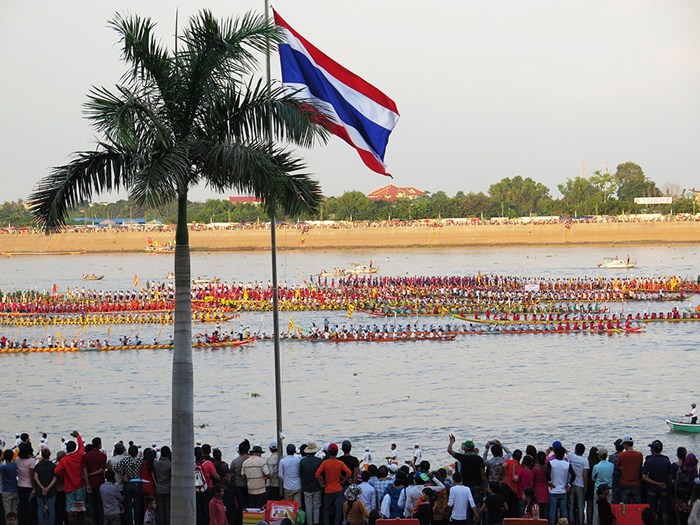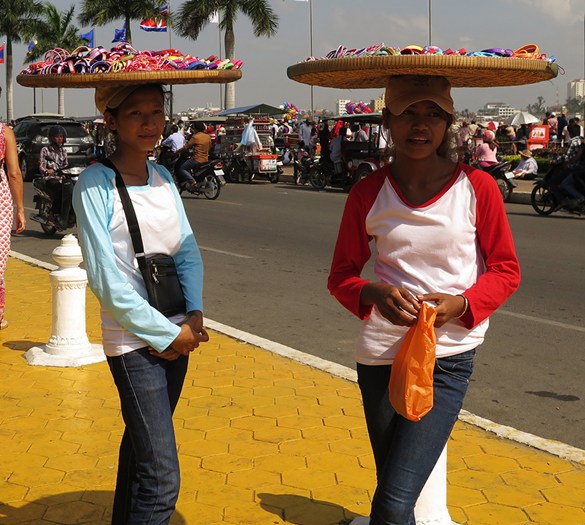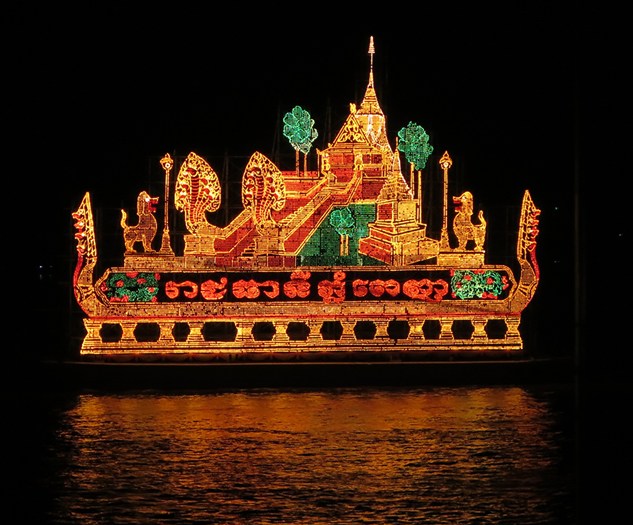PHNOM PENH, CAMBODIA - We arrive at the boulevard running along the Mekong before the boats have begun racing. The streets have been decreed pedestrian only and are empty of their notoriously chaotic traffic. The city is quiet without its usual din of motorbikes, tuk tuks, cars and Hummers, and I can’t quite believe I don’t have to triple-check for SUVs before crossing the street.
The sidewalks gleam with fresh paint, and there’s no garbage anywhere. Phnom Penh has been shined and polished for Bon Om Touk, the three-day Water Festival.
Millions come to the city every November to celebrate the end of Cambodia’s rainy season with boat races, river processions, fireworks and concerts — my ragtag group of Canadians, Brits and Australians among them.
Throngs of people walk in the sunshine, stopping to buy bamboo sticky rice, dried fruit or juice from the many vendors lining the street. Families gather for picnics on colourful woven mats. A motorbike drives by with a load of yellow and red duck and bear balloons.
Having been in Cambodia for over a year, I know it’s special to see so many people enjoying the festival in the streets. Most Cambodian holidays take place in homes and at pagodas, but because the Water Festival is public anyone can take part in the fun.
Long dragon boats hug the riverbank, waiting to race. Qualifying races are held in each of Cambodia’s 24 provinces and the winners are sent to compete here. Each boat is identified by a number on a yellow flag flying at its stern. I see a flag that says 205 and marvel at the hundreds of boats stretched out along the river nearly as far as the eye can see — bright red, yellow and orange gleam against the silver river.
Some boats hold as many as 60 paddlers dressed in identical colours, stroking more or less in time. Small offerings of fruit and incense sit at the bow of the boats.
Not all the boats are the same. In some, the paddlers are seated, and in others, they perch precariously and bend at the waist as they row.
Along the river is a conspicuous blue and red grandstand announcing “Free Admission for Foreign Visitors.” The group I’m with immediately agrees to take advantage of the opportunity. We get front-row seats in the shade.
Pamphlets on each chair outlines the history of the festival and headsets translate the words of an unseen announcer into English. The translation is heavy on government propaganda and light on useful information about the races, however, so we cast the headsets aside to focus on what we see rather than what we hear.
The races are impressive. With each powerful stroke, the boats surge down the river as onlookers cheer. I wonder if people are betting on the races. Although it’s illegal for Cambodians to gamble, they love to anyway and will bet on anything, including the rain.


Left: Boats fill the water and people line the river bank. Right: Hawkers stay cool under the sun.
Though I’ve looked for a program of events, I haven’t been able to figure out when the fireworks start that night. When I ask one of the staff at the foreigners’ tent, he gives me a vague answer, in the typically Cambodian manner.
The fireworks will happen when it’s dark, and anything more specific is not necessary. In Cambodia, pinning down a straight answer is like swimming against the current; you quickly learn you’re going to end up down river anyway, and it’s much easier to go with the flow.
After the races we go to the Foreign Correspondents’ Club to eat. Many bars and restaurants line the riverfront, but none are as elegant or as famous as the FCC. There’s lots of history in its French colonial walls.

Above: Some colourful floats are featured in the water parade.
The FCC was established in 1993 after a United Nations peacekeeping force arrived to conduct Cambodia’s first-ever elections. It quickly became the hangout for U.N. officials, diplomats and journalists.
Nate Thayer, the last journalist to interview the elusive dictator Pol Pot, filed stories from the FCC back in the days when Phnom Penh was a wild frontier city.
While I wouldn’t say the city has been tamed – indeed, its rough edges are what make it fascinating — it’s certainly much calmer than it was then. This is clear during Bandaet Pratip, the illuminated water ceremony on the final night of the festival. Pressed shoulder-to-shoulder, the large crowds are excited but calm.
I stake out a spot at a bar with friends. The bar requires us to buy food, but the cost is worth the view. We overlook the river and have ready access to cheap cocktails.
Illuminated boats float down the river past hundreds of thousands of onlookers. Compared to the fury of the dragon boats, they are tranquil and serene, slowly gliding along the black river.
The lights on the boats form ornate icons commonly seen in Cambodia: king cobras and lions.
One boat shows a map of Cambodia with each of the provinces labelled, while another shows Wat Phnom, the hill and pagoda after which Phnom Penh was named.
Then the fireworks start. They cast a red glow on the crowds and river below, and they impress even me, though I’m used to lavish fireworks on Canada Day in Ottawa.
When the show is over, we have another drink and wait for the traffic to clear. A quiet Buddhist pagoda across the street from the bar serves as a stark contrast to the furor of motorbikes and cars outside its gates. Their red and white taillights are almost as bright as the lights from the boats. Just like that, Phnom Penh is back to normal, chaotic traffic and all.
The traffic may take a while to clear, but I’m enjoying a $4 cocktail and sitting in 31C weather in November. I’m in no hurry to leave.
Information
Tour East Holidays offers a number of tours to Cambodia and other parts of Indochina. Contact one of their tour experts at
www.toureast.com for more information on when’s the best time to visit Cambodia.
About the Author
Allison Jane Smith is a writer who once moved to Cambodia on a whim. She spent two years in Southeast Asia, traveling and writing for publications like Matador Network, Nowhere, TakePart World, and others. Now back in Canada, she writes about politics, travel, and social change. You can follow Allison on Twitter: @asmithb